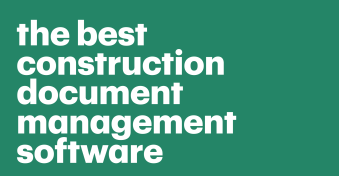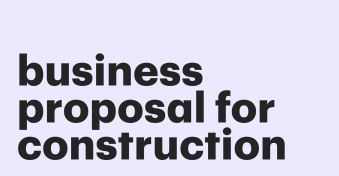Construction project costs can go off the rails if there’s no mechanism for tracking the cash flow and expenditures.
Natural disasters, poor planning, and socio-economic factors can derail construction work at any stage.
It all depends on how your accountants and financial managers track construction costs. Modern construction companies use construction management software to monitor expenses all the way down the line.
The consequences of not doing so are dire. Remember the Big Dig? This project went from an initial $2 billion estimate to a final cost of $14.8 billion.
Although the cost overrun didn’t nail the Big Dig’s coffin, megaprojects like The Tower of David in Caracas got caught in a corrupt, bureaucratic tornado.
In this article, I’ll discuss how construction project cost tracking works and the benefits of meticulously monitoring the flow of funds.
Key takeaways
- Tracking construction costs involves painstakingly gathering all spending data to account for every penny spent directly or indirectly on a project.
- Companies focus on tracking project costs, including direct, indirect, fixed, and variable costs, according to industry standards.
- Contractors and builders can improve their bottom line by correctly estimating budgeted costs and tracking spending metrics throughout the project life cycle.
Types of project costs to track
Construction costs can be direct or indirect, as well as fixed or variable. Let’s break down the costs that go into project planning.
Direct costs
Direct costs (also known as hard costs) refer to all expenses that directly affect the construction project.
These include the cost of labor, materials, waste management, storage facilities, vehicles, and equipment.
Indirect costs
Indirect costs (also known as soft costs) are necessary for project completion but are directed towards peripheral construction services.
Some indirect expenses include inspection and licensing fees, insurance and security fees, project management charges, etc.
Fixed costs
Fixed costs remain the same throughout the duration of the project. Examples include licensing fees and lease payments.
Variable costs
Variable costs change with economic and social conditions. Some variable project expenses include material costs, repair and maintenance fees, commissions, etc.
Tracking these actual costs will help you choose the type of construction contract to use for every project. It will help you decide whether to work with a fixed priced contract or a unit pricing model.
What should a cost report contain?
Cost reports can vary by project type or size — the report for building a bridge would differ from a simple residential remodeling report. Here are the key elements included in a job costing report:
- Initial budget: This is the original amount or total cost allocated for the entire project or one unit of the construction job. Construction accounting systems use this figure to set the benchmark for other cost estimates.
- Revised budget: This is the updated version of the initial project budget after factoring in change orders as the project progresses.
- Direct and indirect costs: Direct costs focus on the tangible units of construction, while indirect costs focus on non-tangible construction budget tracking.
- Change orders: These are modifications in scope, material requirements, or schedule that have been approved by both the general contractor and owner.
- Committed costs: These are construction project costs that have already been doled out for hiring labor, leasing equipment and storage space, and buying building materials.
- Projected costs: These are expected expenses based on data-based forecasting and experience-based estimates. This figure is usually within a projected price range.
- Asset inventory: This provides a quick overview of all available materials in storage and the equipment on-site.
Using construction project tracking software can help you generate regular or ad-hoc cost data reports when needed.
Why you need project cost tracking
Here are the benefits of construction cost management and tracking:
- Cost-tracking solutions help you save money by setting off alarm bells once your spending starts drifting into the red zone.
- It gives you access to advanced data analysis tools for reorganizing and optimizing your expenses.
- Construction project tracking software gives you access to real-time reporting, which speeds up financial and administrative decision-making processes.
- It helps you generate reports, bills, timesheets, and invoices faster by giving you a clear view of price changes and integrated services in the construction industry.
- Centralized construction cost tracking improves transparency between contractors and project owners. Keeping detailed records can also protect you from legal problems, especially with government contracts.
- Tracking construction costs helps you generate estimates by harnessing historical data from previous projects.
- It helps you manage change orders without impacting initial project estimates or your bottom line.
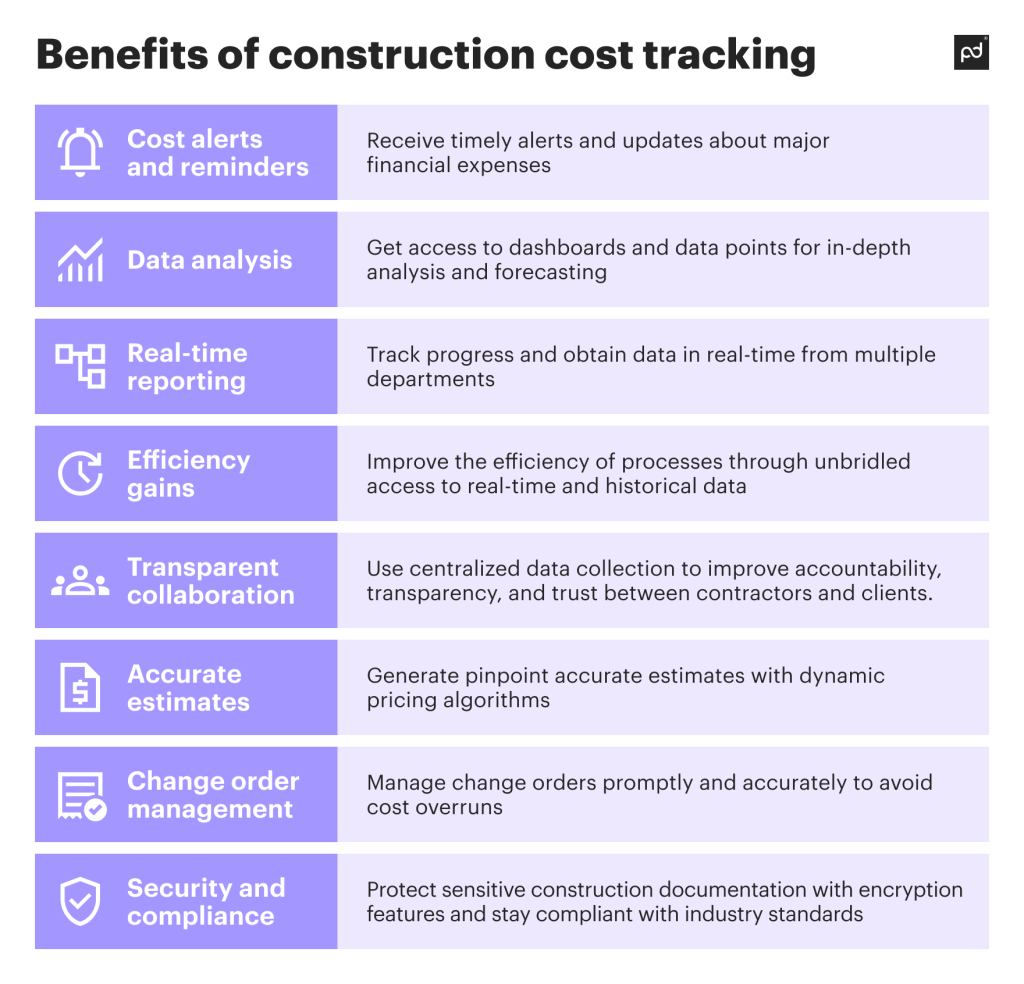
Tips for tracking project costs
If you want to track project costs, here are some expert tips to follow:
Establish a baseline
To establish a cost baseline, gather all the necessary information when making estimates. This will help you figure out when you are running out of funds at any interval during project execution.
The agreed-upon budget and margin would dictate the baseline as well as the milestones, timelines, overhead, and revenue.
Keep detailed records
The project manager or site manager must keep accurate records of every cent spent on hiring subcontractors and laborers as well as buying building materials.
This also involves updating the inventory and outlining functional and non-functional equipment. Pay special attention to adjustments in billable hours and change orders.
Manage change orders meticulously
Failure to track change orders will derail your accounting and lead to cost overruns. You don’t want the project to get stuck in limbo while you balance the books with contractors.
For instance, adding new HVAC systems to residential buildings can change the overall cost of the project.
That’s why the project team must establish a comprehensive change order process to approve modifications to the initial scope and budget.
Communicate regularly
Project owners should demand regular financial updates from project managers or site supervisors. They can also ask general contractors to provide receipts and purchase orders at specific intervals to make sure they tally with the official accounting.
Assign a dedicated financial manager
For small projects, hiring a dedicated financial manager might seem like overkill. But for large-scale construction works, you need a dedicated financial manager in charge of the books.
Why? Because an experienced accountant will focus squarely on keeping the project’s financial outlook within the initial budget.
Financial experts also know how to categorize expenses in order to streamline project cost tracking.
Learn from previous projects
Even though the construction landscape is dynamic, monitoring previous financial trends will help your organization track costs better and refine the budget.
Young construction companies often struggle with massive projects because they lack field experience. Conversely, massive construction companies can tap into historical data to avoid cost overruns and improve profits.
Conduct regular audits
As part of constant communication, demand spending reports from contractors are sent at regular intervals. This should be part of scheduled reviews and progress updates.
Even if you have a cost tracking solution, schedule meetings to go over the financial implications of projects after every milestone.
Choose a cost tracking solution
Construction budget tracking software helps you centralize and automate different modules involved in cost control.
Every cost tracking software for construction tallies all expenses to generate accurate reports and receipts. Financial managers can use them for resource allocation in order to balance out expenses.
They also contain construction budget templates and dashboards for time tracking, scheduling, and payroll management for labor costs. Contractors can use it for asset management.
How to track project costs with PandaDoc
PandaDoc is not full-scale construction cost tracking software, but it can help you out with small contracts. Now, let’s go through a practical budget management scenario for a construction project using PandaDoc.
1. Open the PandaDoc app.
2. From the sidebar, insert a Pricing Table widget. You can choose one from the templates library.
3. Fill in the tables with the necessary values and prices.
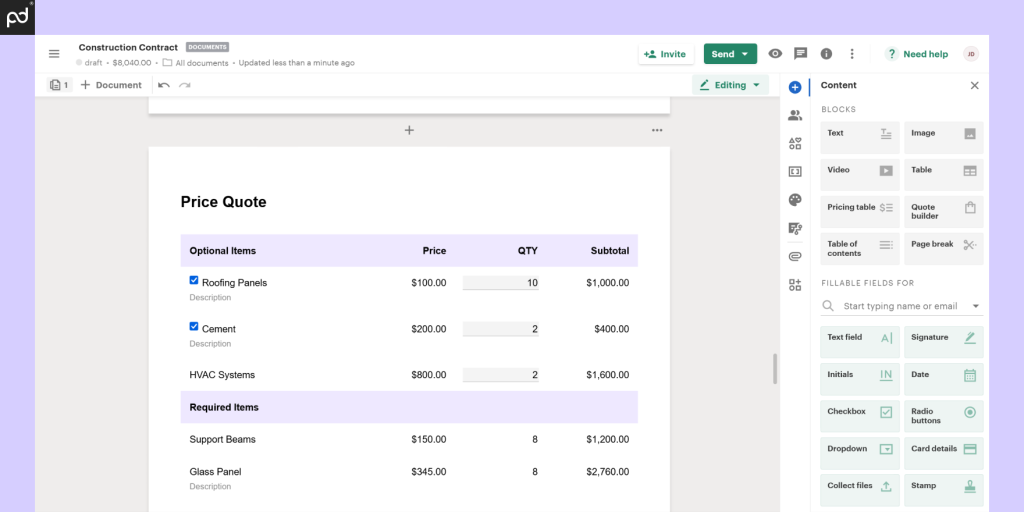
4. Alternatively, import a catalog of products from the inventory you created earlier. This ensures you account for every labeled expense.
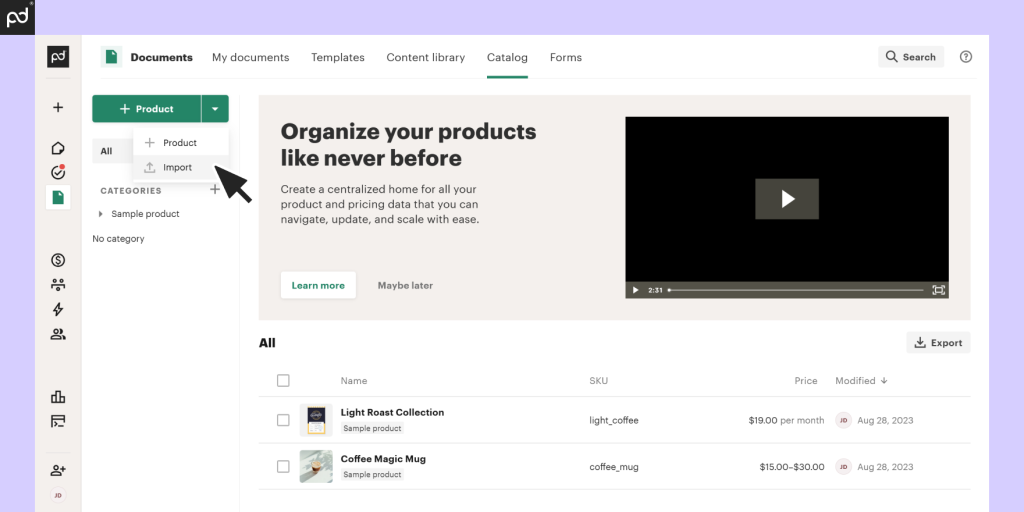
5. Add change orders to the pricing list to obtain the exact figures based on the available data.
6. Add extra elements such as signatures, stamps, logos, etc.
7. Integrate data with Salesforce and other CRMs to make use of their analytical tools.
8. Export the report as Excel spreadsheets or PDFs.
9. Tag the stakeholders to review the document.
Calculating cost and profit margin together
With PandaDoc Business and Enterprise plans, you and your team have the ability to easily calculate costs, profits, and the profit margin (percentage) for all transactions. Also, it’s internal data only — enabling this feature will only be visible to those with account access (your clients or document recipients won’t see the calculations).
Here’s how to do it:
- Enable Cost and Margin Calculation from the Add-on store under Proposal & Quotes.
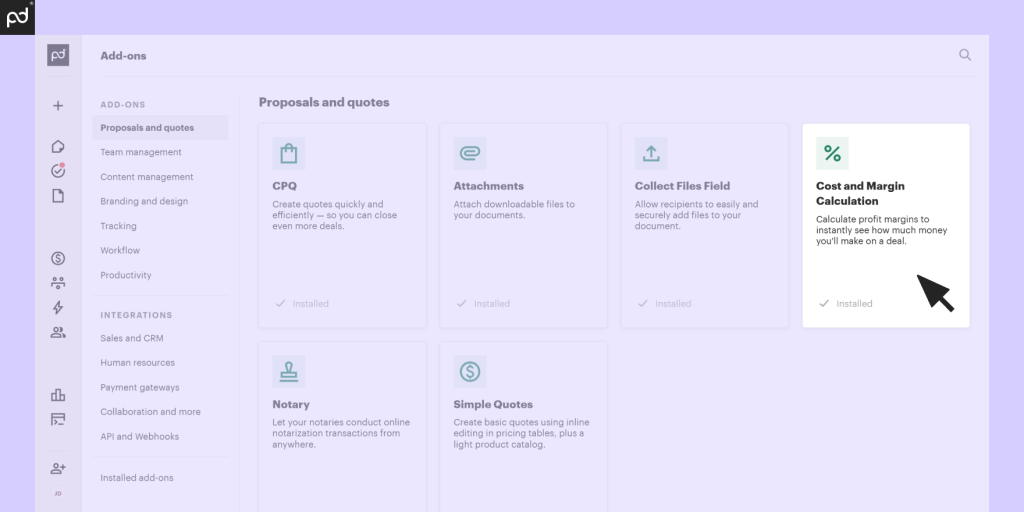
- Open a template or document with a pricing table.
- Click the right-side panel in the pricing table and choose “Cost” under “Add hidden.”
- If a product’s cost is 0 in your catalog, click the cell and add a value.
- Go to “Apps” on the right, then click “+Add” on the “%Profit Margin” tile.
Here’s what the process looks like:
A full explanation for this feature may be found at the PandaDoc Help Center.
Save every last penny on your projects
Contractors, architects, and property owners use construction project management software to monitor and optimize expenditures.
This SaaS solution is further leveraged when paired with tools that enhance profitability margins by automating workflows.
PandaDoc is here to help. With a library of customizable construction proposal templates, contract management solutions that assist negotiations to close deals faster, and dedicated tools to track and report project expenses, the platform saves you time — and money!
To learn more about how cost tracking on construction projects can become transparent and frictionless, schedule a free demo today.
Disclaimer
PandaDoc is not a law firm, or a substitute for an attorney or law firm. This page is not intended to and does not provide legal advice. Should you have legal questions on the validity of e-signatures or digital signatures and the enforceability thereof, please consult with an attorney or law firm. Use of PandaDoc services are governed by our Terms of Use and Privacy Policy.
